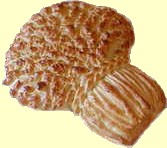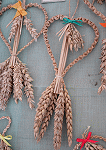I found the most fascinating site at a junior school in Kent, my home county and I am happy to share some of their information.
Occurring one quarter of the year after Midsummer, Harvest Festival represents midautumn, autumn’s height. It is also the autumnal equinox, one of the quarter days of the year.

Harvest Festival used to be celebrated at the beginning of the Harvest season on August first and was called Lammas, meaning 'loaf Mass'. Farmers made loaves of bread from the new wheat crop and gave them to their local church. They were then used as the Communion bread during a special mass thanking God for the harvest. The custom ended when Henry VIII broke away from the Catholic Church, and nowadays we have harvest festivals at the end of the season.
Farmers celebrated the end of the harvest with a big meal called a harvest supper, eaten on Michaelmas Day. This was rather like a Christmas dinner, but as turkeys were unknown at that time, a goose stuffed with apples was eaten. Goose Fairs are still held in some English towns, but geese are no longer sold.
Michaelmas used to be the commonest day for the winter night curfew to begin - the first hint that winter was on the way.

The Michaelmas Daisies, among dede weeds,
Bloom for St Michael's valorous deeds.
And seems the last of flowers that stood,
Till the feast of St. Simon and
Curfew took the form of a tolling of the church bell, usually one strike for each of the days of the month that had passed in the current year and generally rung at 9pm.
The word curfew may derive from the French word couvre feu, meaning 'cover fire'. Curfew was the time when household fires were supposed to be doused. The bell was tolled every night, apart from Sunday, until Shrove Tuesday.
Chertsey is one of the last places to still ring a Curfew bell at 8pm from Michaelmas Day to Lady Day (29th September to 25th March). Their oldest Curfew bell dates from 1380!
The tradition of celebrating Harvest Festival in churches as we know it today began in 1843, when the Reverend Robert Hawker invited parishioners to a special thanksgiving service for the harvest at his church at Morwenstow in Cornwall*. Victorian hymns such as "We plough the fields and scatter", "Come ye thankful people, come" and "All things bright and beautiful" helped popularise his idea of harvest festival and spread the annual custom of decorating churches with home-grown produce for the Harvest Festival service.
Corn Dollies
The making of corn dollies goes back many thousands of years. It was a Pagan custom and evolved from the beliefs of the corn growing people who believed in the Corn Spirit.

Corn dollies were made at Harvest time from the last sheaf of corn cut. The Corn Spirit was supposed to live or be reborn in the plaited straw ornament or corn doll and was kept until the following spring to ensure a good harvest. .The corn dolly often had a place of honor at the harvest banquet table.
The craft was brought to a halt by the advent of mechanization in the 1800s, but is now being revived as a fascinating hobby.

Other rituals and ceremonies
· Church bells could be heard on each day of the harvest.
· The horse, bringing the last cart load, was decorated with garlands of flowers and colourful ribbons.
· A magnificent Harvest feast was held at the farmer's house and games played to celebrate the end of the harvest.
In the rhythm of the year, Harvest Festival marks the beginning of a time of rest after hard work. The crops are gathered in, and winter is still a month and a half away! Although the nights are getting cooler, the days are still warm, and there is something magical in the sunlight, for it seems silvery and indirect. As we pursue our gentle hobbies of making corn dollies our attention is suddenly arrested by the sound of baying from the skies (the “Hounds of Annwn” passing?), as lines of geese cut silhouettes across a harvest moon. And we move closer to the hearth, the longer evening hours giving us time to catch up on our reading while sipping home-brewed mead or ale. What a wonderful time Harvest Festival is!
No comments:
Post a Comment